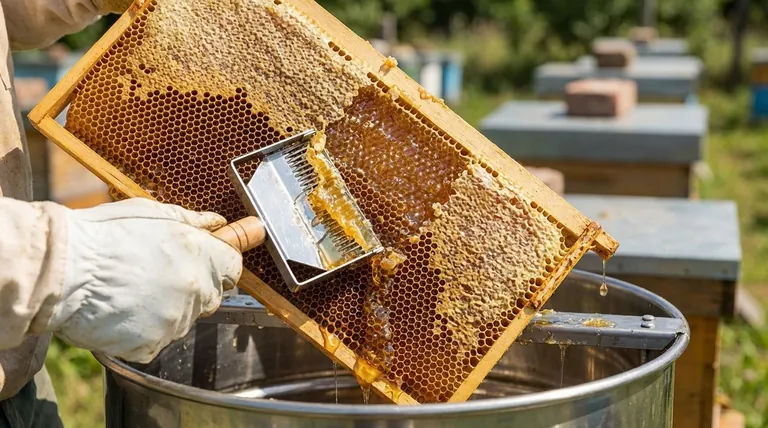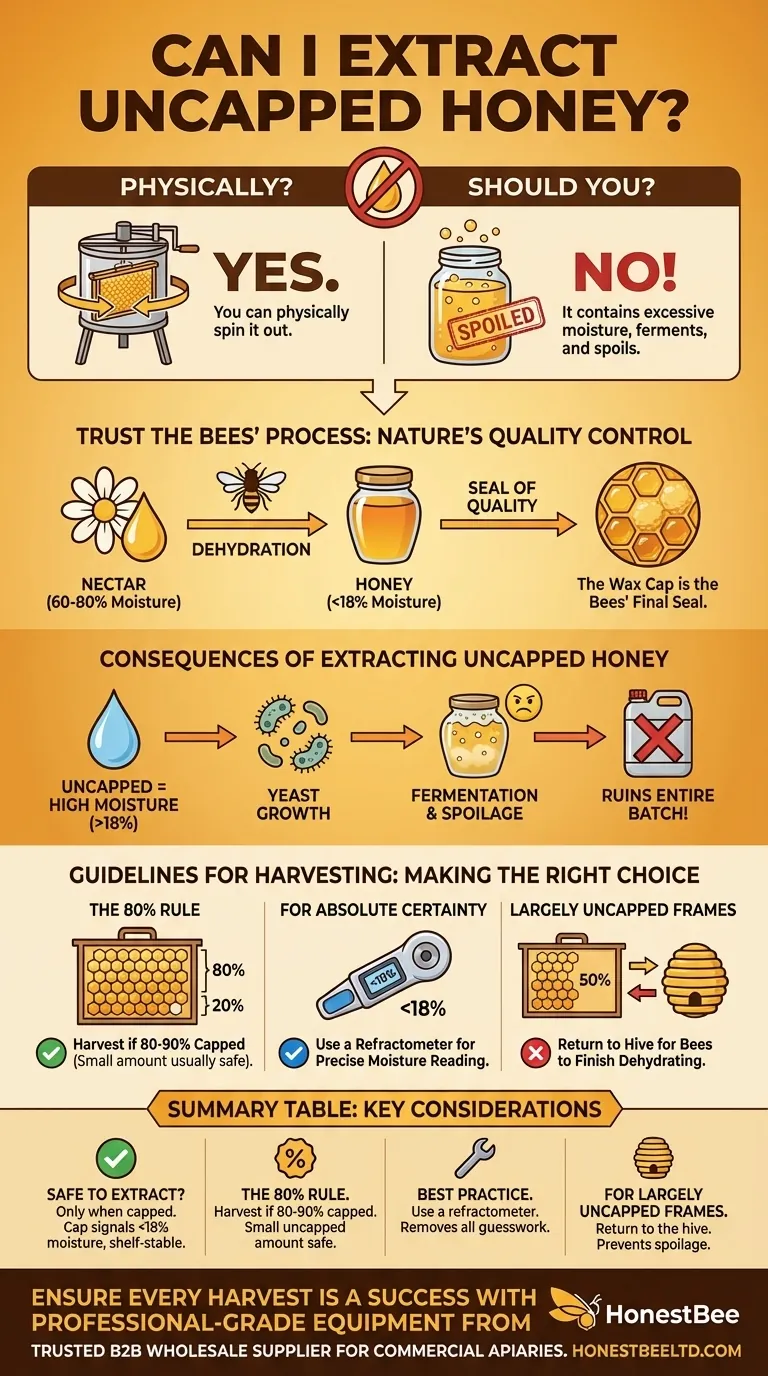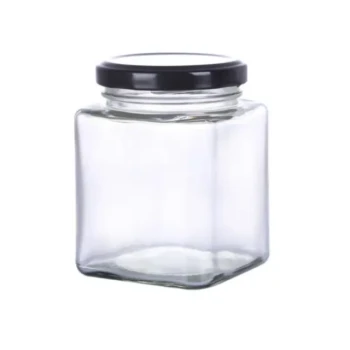While you can physically spin uncapped honey from a frame, you should not. This uncured "honey" contains excessive moisture, which will cause your entire batch to ferment and spoil. The beeswax capping is the bees' signal that the honey is properly cured and ready for long-term storage.
The central principle of honey harvesting is trust in the bees' process. The wax cap on a honeycomb cell is not an obstacle to be removed, but a seal of quality, indicating the honey has reached a stable moisture content (below 18%) and is safe from fermentation.

Why Bees Cap Honey: Nature's Quality Control
To understand why extracting uncapped honey is a mistake, you must first understand why bees cap it. The process is a form of natural quality control that ensures the honey's longevity.
The Journey from Nectar to Honey
Nectar, the raw material for honey, is collected from flowers and is naturally high in water, often containing 60-80% moisture. This liquid is unstable and would quickly spoil on its own.
The Critical Dehydration Process
Inside the hive, bees work to transform nectar into honey. They pass it from bee to bee, adding enzymes, and spread it across the comb. They then vigorously fan their wings, creating airflow that evaporates the excess water.
This "curing" process continues until the water content drops to a crucial threshold of around 17-18%.
Capping as the Final Seal
Once the honey reaches this low moisture level, it is resistant to spoilage from wild yeasts and bacteria. The bees then seal the cell with a fresh layer of beeswax. This capping is the final signal that the honey is mature, stable, and ready for long-term storage.
The Consequences of Extracting Uncapped Honey
Ignoring the bees' signal and extracting uncapped honey introduces significant risk to your harvest. This is not honey; it is still, in essence, high-moisture nectar.
The Problem of High Moisture
Uncapped honey has a water content well above the stable 18% threshold. This excess water creates the perfect breeding ground for naturally occurring osmophilic yeasts that are always present in honey.
Inevitable Fermentation and Spoilage
With enough water, these yeasts will begin to multiply and metabolize the sugars in the honey. This process is fermentation. It will give the honey a sour, "off" taste, and you may see bubbling as carbon dioxide is produced. The honey is spoiled and unsuitable for consumption.
Compromising Your Entire Batch
Even a small amount of high-moisture, uncapped honey can ruin your entire harvest. When mixed with properly cured honey, it can raise the overall moisture content of the entire container above the safe threshold, putting the whole batch at risk of fermentation.
Understanding the Trade-offs: The "Mostly Capped" Frame
In practice, beekeepers often find frames that are not 100% capped. This is where careful judgment is required.
The "80% Capped" Rule of Thumb
A widely accepted guideline is that a frame is safe to harvest if at least 80-90% of the cells are capped. The small amount of uncured nectar in the remaining cells is generally not enough to raise the overall moisture level of the extracted honey to a dangerous point.
For Absolute Certainty: Use a Refractometer
The only way to know the exact moisture content of your honey is to use a honey refractometer. This simple tool measures how light bends through a liquid, giving you a precise reading of its water content. For serious beekeepers, this removes all guesswork and ensures a high-quality, stable product.
Handling Largely Uncapped Frames
If a frame has large, significant patches of uncapped cells (e.g., it is only 50% capped), do not extract it. The best and safest course of action is to return the frame to a strong hive. The bees will finish the dehydration process and cap the cells when the honey is truly ready.
Making the Right Choice for Your Harvest
Your decision should be guided by your goal for a stable, high-quality product.
- If your primary focus is a premium, shelf-stable product: Only extract honey from frames that are at least 80-90% capped, or use a refractometer to confirm the moisture content is below 18%.
- If you have partially capped frames: Return any frames with significant uncapped areas to the hive for the bees to finish their work. This is the safest and most reliable path.
- If you absolutely must know if uncapped honey is ready: Test a sample from the uncapped cells with a honey refractometer. Do not rely on guesswork.
Ultimately, patience is the beekeeper's greatest tool; trust the bees to tell you when the honey is perfect.
Summary Table:
| Key Consideration | Guideline | Why It Matters |
|---|---|---|
| Safe to Extract? | Only when cells are capped | The wax cap signals honey is cured (<18% moisture) and shelf-stable. |
| The 80% Rule | Harvest if 80-90% of cells are capped | A small amount of uncapped honey is usually safe when mixed. |
| Best Practice | Use a honey refractometer | Provides a precise moisture reading, removing all guesswork. |
| For Largely Uncapped Frames | Return the frame to the hive | Let the bees finish dehydrating the nectar to prevent spoilage. |
Ensure every harvest is a success with professional-grade equipment from HONESTBEE.
As a trusted wholesale supplier for commercial apiaries and beekeeping equipment distributors, we provide the durable, reliable tools you need for a quality harvest. From honey refractometers for precise moisture testing to robust extractors built for high-volume operations, our products are designed to support your business's efficiency and reputation.
Let's discuss your apiary's specific needs. Contact our wholesale team today to get the right equipment for a perfect, stable harvest, season after season.
Visual Guide

Related Products
- Extra Wide Stainless Steel Honey Uncapping Fork with Scraper Beekeeping Tool
- Professional Wide Blade Honey Scraper for Beekeeping and Honey Processing
- Professional Long-Handled Silicone Honey Scraper for Beekeeping
- Honey Wax Separating Wax Press with Metal Screw Wax Separator Machine
- Stainless Steel Honey Press Wax Press with Tank
People Also Ask
- How long does it take to extract honey from frames? Plan Your Harvest Efficiently
- Why is my honey frame not capped? Your Guide to Perfectly Ripe Honey
- What other tools are available for honey uncapping besides knives? Find the Right Tool for Your Apiary's Scale
- What equipment is needed for honey extraction? The Essential Gear for Every Beekeeper
- Why are my bees not capping honey? Understand the Key to Perfect Honey Ripening



















